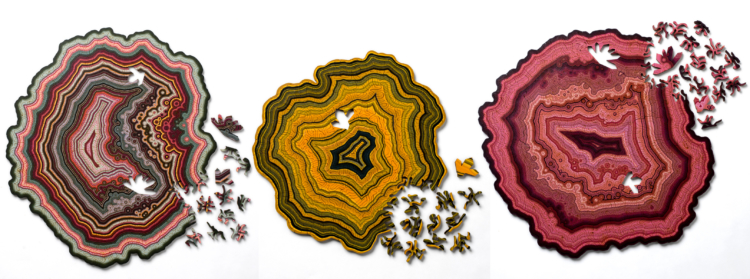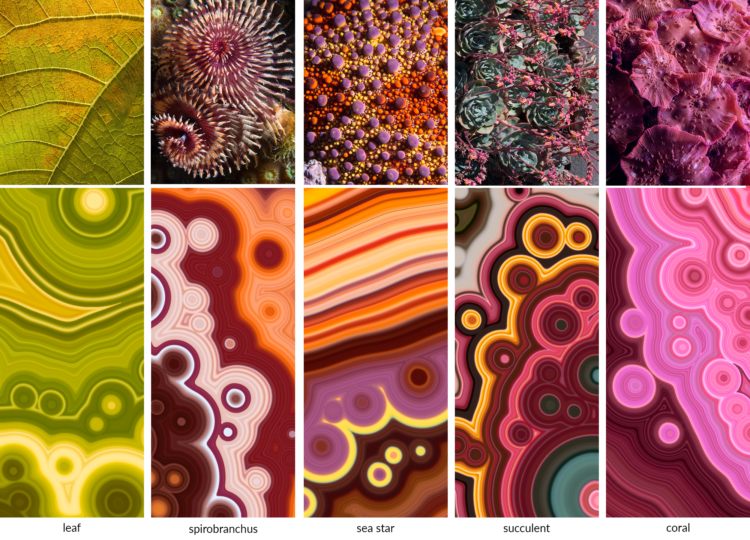Geode, Maze, and Custom Jigsaw Puzzles

Geode is the latest fiendishly difficult jigsaw puzzle from “the monsters” who created the Infinite Galaxy Puzzle (that’s us!). It features a new style of puzzle cut we’re calling Maze, with algorithmically generated pieces that twist into incredibly distorted shapes. We’re also introducing a new Custom Puzzle maker on our website that lets you order our lasercut wood puzzles with any image and shape. Read on for the story behind our new Geode Puzzles, algorithmic Maze puzzle generator, Custom Puzzles, and more!
Geode: geologically inspired puzzles





Geode is a jigsaw puzzle inspired by the formation of agate, a colorful banded stone. Each puzzle is unique, emerging from a computer simulation that creates natural variations in the shape, pieces, and image. Hundreds of lasercut plywood pieces intertwine to form a challenging, maze-like puzzle. Each geode is a slice of an algorithmic rock. The puzzles come in two varieties: Geode ($60, ~180 pieces) and Orbicular ($95, ~370 pieces), now available for purchase in our shop.
Agates typically form in voids within volcanic stone. Bubbles of gas leave pockets in the rock which fill with a silica-rich solution. Under the right conditions, this silica solidifies into a microcrystalline gemstone called agate. The way it solidifies is really neat. It begins to crystallize from the outside in, with a layer forming first against the chamber wall. Concentric layers of mineral deposition create colorful bands as the chemical composition of the silica gel changes.
Our computer generated agates emerge from a similar process. First, we grow a chamber (this will be the shape of the puzzle). Then we progressively grow the edge inward, perpendicular to the boundary, until the chamber is filled. Each band of growth exhibits slight changes in growth rate, color, and character, resulting in a unique pattern.
Real agates get their colors from dissolved impurities (mostly oxidized iron) which are present in the silica gel (or later infiltrate). Our agates derive their colors from a pool of photographs, all taken by Jessica. With each new band, we travel across the photo, sampling its color.
The generated images are like slices of algorithmic rocks, each with its own unique shape and topography of layers that references an artificial geology. The different color families hail from specific geographic locales where the photos were taken, from the reefs of Bonaire to the coast of New England.
The larger Orbicular Geode Puzzles ($95, ~370 pieces) feature zones of orbicular pattern, bubble-like disruptions in the bands. We create these by introducing new seeds of growth during the generation process. Similar patterns are seen in tube agates where needle-like crystals of other minerals like goethite are present in the chamber and create additional surfaces for templating growth.


Maze: a new generative system for making puzzles
We’ve been making puzzles since 2012 with a unique cut style we designed based on crystal formation. The puzzle’s pieces grow into each other, interlocking with shapes similar to dendritic crystals or ice formations. After the viral infinity puzzle incident of 2016, we started thinking it was time to expand our puzzle offerings with a new cut style that featured a different kind of interlocking shape.
For that reason, we created a brand new process for generating jigsaw puzzles: Maze! It is our most intricate cut style, with almost twice the number of pieces as our other puzzles. The pieces are so stretched and distorted that it can be hard to distinguish where one ends and another begins. When examined individually, the pieces almost look like strange glyphs from an alien alphabet.
This new puzzle cut style is based on a simulation of growing elastic rods. However, it didn’t start out as a puzzle-making system. Originally, it was a 3D system for making expanding lattices using a technique called Position and Orientation Based Cosserat Rods—but that is a project for another time. We realized that in 2D, it would make interesting interlocking shapes.
The Maze puzzle generation starts the same as our Dendrite system. The initial piece shapes grow via reaction diffusion. Each piece is its own chemical component, which actives its own production and inhibits everything else. Starting from an initial point, the pieces expand, wrapping around the border and whimsy pieces, until they reach each other and fill the puzzle.
From here, Maze diverges from our first puzzles. The edges of this pattern are turned into elastic rods. Each rod wants to be straight; but in the confined space of the puzzle, they are forced to bend as they grow. The rods grow, lengthening, until they collide, pushing each other into contorted shapes. (Disclaimer: Maze style not actually a maze.)


Left: The very first Maze cut experiments as teeny tiny puzzles! The one on the upper right is on a rectangular grid vs. a Voronoi grid. Right: Another early Maze puzzle cut experiment. This one was a little too detailed, resulting in giant, overly fragile pieces.
Custom Puzzles
Instead of having our puzzles mass-produced, we make them all in-house with code and a laser cutter, allowing each one to be one of a kind. We open up that process to you with our new and improved custom puzzle maker. You can personalize every aspect of the puzzle, including the image, shape, and whimsy pieces. You are no longer limited to rectangular or circular puzzles—you can design your own shape. Wish someone happy birthday with a cake puzzle! Make a puzzle of your cat, shaped like a cat, with cat pieces in it!


Select from our growing catalog of whimsy pieces shaped like recognizable creatures (from cats to narwhals), objects (space shuttles to crystals), and letters. This allows you to artfully arrange your pieces or insert a hidden personal message. Our algorithmic puzzle technique lets us “grow” the puzzle pieces around your whimsies and within your puzzle shape.
Choose from 3 different cut styles: Amoeba, Dendrite, and Maze. Amoeba has ~1.9 puzzle pieces per square inch: a 10×10” puzzle has 190 amoeba pieces. Dendrite has ~1.8 pieces per square inch: a 10×10” puzzle would have 182 Dendrite pieces. Maze has a whopping 3.7 pieces per square inch: a 10×10” puzzle has 367 Maze pieces.
Shop all of our generative jigsaw puzzles here!
Open source libraries used
openframeworks: C++ creative coding platform
Clipper: tool for boolean operations on polygons
PositionBasedDynamics: library for physics simulations
Eigen: matrix library















Paul Strauss
Incredible. We’ll be sharing these on The Awesomer later today.
Alice Knudsen
Wondering when the next batch of geode puzzles will be out. Have seemed to miss the last one for Christmas that came out earlier today.
Annie
Hi,
I recently bought one of the geode puzzles! I was just wondering what size picture frame would you recommend?
Jessica
Hi Annie, Each one is a different shape and size so I am not sure what size frame would work for yours. We haven’t framed any of our puzzles before. We recommend disassembling so you can do them again!
Lurm
These—along with just about everything I’ve seen from your team—are incredible. Thanks for making beautiful, awesome things.
Allison Thompson
Got my first Maze puzzle for Christmas and I am Hooked! I want them all!